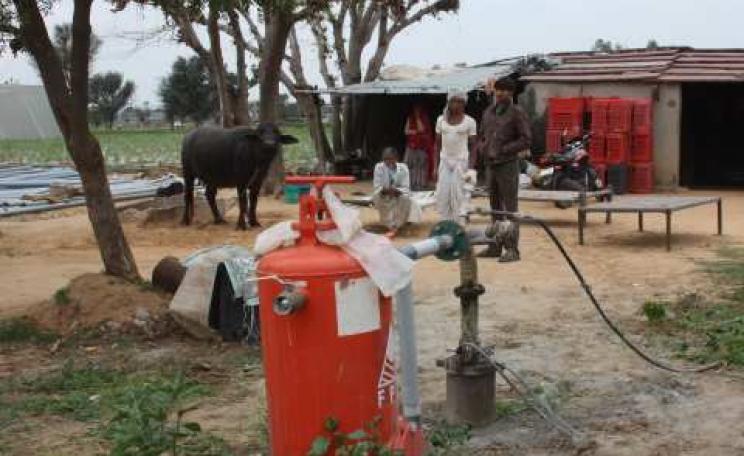Sometimes it's the simplest of technologies that pay the greatest dividends
Access to safe water and sustainable energy are inextricably linked, and extremely important if we are to achieve the Sustainable Development Goals by 2030. More than 660 million people globally - or one in 10 - lack access to safe drinking water. This has devastating health consequences and causes more than 1.5 billion deaths every year. Most still rely on surface, well or spring water for their water supply and require energy to pump ground water or boil it using wood, kerosene or liquefied petroleum gas (LPG). However, water is often not boiled for long enough or stored properly afterwards, so it still contains pathogens and is often highly contaminated.
New for this year in the annual Ashden Awards - which celebrate sustainable energy trailblazers around the world - is an award exploring the nexus of energy and water. Nazava Water Filters, the winner of the 2016 Ashden Award for Sustainable Energy and Water, is helping tackle the problem of access to safe drinking water in Indonesia, where women struggle to get safe drinking water for their families, and where around 15,000 children under the age of five die from diarrhoea and other water-borne diseases every year.
The company has developed a low cost water filter made using two locally-available transparent plastic containers stacked one on top of another with a ceramic filter candle in between. The filter candle blocks pathogens and solid particles from passing through and reduces chemical contamination, thereby improving both the taste and odour of the water. Safe drinking water is dispensed through a tap in the lower container, making the filter a functional and aspirational household item for rural households, available in different shapes, sizes and colours.
The most popular filter costs $20, which can be paid for in cash or in instalments, which means this household-level approach provides a cheaper and more reliable alternative to boiling or buying treated water, especially in isolated areas or on small islands. Eliminating the use of fuel to boil water cuts greenhouse gas emissions, saving about 10,000 tonnes/year CO2.
To date, over 50,000 filters have been sold through an effective network of more than 120 women resellers, including community health workers and midwives working with the Ministry of Health, benefitting 200,000 people with affordable access to safe drinking water.
Runner up in the 2016 Ashden Award for Sustainable Energy and Water, 1001 Fontaines is a French NGO that sets up water treatment kiosks in rural villages across Cambodia, where household income is less than $2 a day.
Using a community-scale, decentralised approach appropriate for supplying safe drinking water to rural and peri-urban areas, the kiosks - that cost around $25,000 to set up - filter and treat surface or ground water (from rivers, lakes, ponds or tube wells) using solar-powered UltraViolet sterilisation techniques.
Sometimes it's the simplest of technologies that pay the greatest dividends
At the same time this creates jobs and supports income generation for local entrepreneurs who are trained to run these kiosks as social enterprises that produce, distribute and deliver large 20 litre bottles of safe drinking water to homes and primary schools. To date some 140 kiosks have been set up, providing 70 million litres of water per year to over 250,000 people in homes and close to 100,000 children in schools.
Sometimes it's the simplest of technologies that pay the greatest dividends. In the Philippines, former Ashden Award winner the AID Foundation (AIDFI) has introduced ram pumps where the power of a river's flow pushes water uphill, helping saving time and money for thousands of villagers.
When you live on a steep hillside, it can be tough to access clean water. Long climbs up from the valleys mean that water use is limited to cooking and drinking with little left over for crops. Many villages farm land on plateaus that are intercut with river valleys, relying on rainfall for irrigation. But the ram pumps mean that up to 10 times more water is available than before so the villagers can cultivate their land much more effectively and produce crops like lemongrass for sale, or diversify into fish farming. As well as being able to grow more crops, the villagers are healthier due to better hygiene - all without the use of fossil fuels.
With the support of the community, AIDFI pumps can last at least twenty years. The success of the scheme has also helped to change the mind-set of local people who now see renewable energy as the best option for them. There is a huge need for this type of technology in areas where there is no immediate access to clean running water.
In addition to providing access to safe drinking water and investing in adequate infrastructure, an important goal for all three organisations is to educate communities on the importance of safe drinking water and hygiene and help change habits and behaviour over time, essential to ensuring universal access to safe and affordable drinking water and improving sanitation and health outcomes by 2030.
As one of AIDFI's beneficiaries put it: "When water is near, life is easier."
About this author:
Chhavi Sharma is International Programmes Manager with Ashden, a charity that rewards, supports and promotes sustainable energy leaders in the UK and developing and emerging economies. Since the Ashden Awards were founded in 2001, Ashden has rewarded 180 enterprises in the UK and around the world which so far have collectively improved the lives of 47 million people, saving more than 9 million tonnes of CO2 emissions every year.






